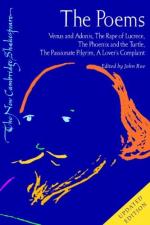|
This section contains 3,579 words (approx. 12 pages at 300 words per page) |

|
SOURCE: "'Single Natures Double Name': An Exegesis of The Phoenix and Turtle," in Generous Converse: English Essays in Memory of Edward Davis, edited by Brian Green, Oxford University Press, Cape Town, 1980, pp. 44-54.
In the following excerpt, Green explicates The Phoenix and Turtle, calling it a love-elegy that muses on three attitudes toward sexual love: "the vulgar, the sublime, and the chaste. "
Roman Jakobson once called The Phoenix and Turtle 'Shakespeare's masterpiece'.1 The poem is quite an astonishing one, a perplexing love-elegy, traditional and yet obscure. In the reading which follows, the poem dramatizes a critical view of two contrary kinds of sexual love. One is selfish and degrading; the other is sterile, cautious, and dogmatic. The poem implies a criticism of both these attitudes, and hints at an ideal of love, the due of a woman who is both chaste and beautiful.
I
Let the bird of...
|
This section contains 3,579 words (approx. 12 pages at 300 words per page) |

|


